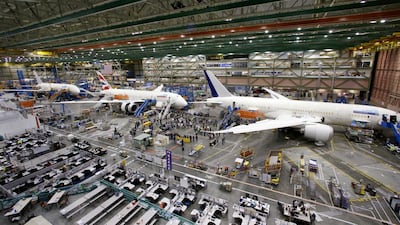Boeing cut its forecast for commercial jet demand over the next decade as the Covid-19 pandemic erodes deliveries before sales gradually recover in the 2030s.
The Chicago-based company projects 18,350 plane deliveries in the period between 2020 to 2029, down 11 per cent from its forecast in 2019 before the Covid-19 crisis decimated demand for air travel and new aircraft. Boeing predicted a market of $2.9 trillion for commercial jets over the next decade.
Growth is expected to pick up in the 2030s, with Boeing forecasting 43,110 commercial aircraft deliveries over the next 20 years. However, this is still 2 per cent below the 44,040 deliveries projected in 2019, worth $6.8tn at list prices.
"Commercial aviation is facing historic challenges this year, significantly affecting near- and medium-term demand for airplanes and services," Darren Hulst, Boeing's commercial marketing vice president, said. "The current disruption will inform airline fleet strategies long into the future, as airlines focus on building versatile fleets, networks and business model innovations that deliver the most capability and greatest efficiency at the lowest risk for sustainable growth."
The 2020 Boeing Market Outlook was the company's first forecast since Covid-19 upended the global aviation industry. The projections are part of Boeing's annual 20-year forecast of commercial jet industry demand.
The pandemic has led governments to impose travel restrictions that have forced airlines to ground thousands of jets, particularly widebodies used on long-haul routes, as international air travel declines.
Boeing expects it will take about three years for air travel to return to 2019 levels, and it will be a "few years beyond that" for the industry to return to long-term growth trends.
Narrow-body aircraft are forecast to lead the way to recovery as domestic and short-haul routes rebound faster than long-haul travel. Passengers will also prefer point-to-point travel, the company said, as opposed to routing through hubs.
Single-aisle airplanes, such as Boeing's grounded 737 Max, will continue to be the largest market segment, with operators projected to need 32,270 new airplanes in the next 20 years, down 0.5 per cent from the 2019 outlook.
Overall, narrow-bodies will make up 75 per cent of total aircraft deliveries in the next 20 years.
Boeing cut its 20-year forecast for twin-engine planes – such as the Boeing 787 Dreamliner and Airbus A350 – by 10.3 per cent to 7,480 deliveries, down from 8,340 a year ago.
"Widebody demand will be affected by a slower recovery in long-haul markets – typical after air-travel shocks – as well as uncertainties from Covid-19's impact on international travel," Boeing said.
In terms of regions, Middle East carriers will take delivery of 2,945 jets in the next 20 years, down from the 3,130 planes predicted in 2019. This brings the size of the regional fleet to 3,500 aircraft by 2039.
Single-aisle jets will make up 52 per cent of the Middle East's aircraft deliveries, followed by 43 per cent of widebodies. Regional jets and freighters make up the remainder.
"Middle East carriers will moderately downsize their fleets to add to the share of smaller widebodies, which can increase the profitability of service to smaller cities or in seasonal slow-demand periods," Boeing said. "Resilient intra-regional and short-haul markets will drive single-aisle demand for both network carriers and low-cost carriers."
Boeing voiced optimism about the global aviation industry's long-term fundamentals, citing its resilience following previous crises, airlines' need to replace older planes and the need for fuel-efficient jets to meet sustainability goals.
"We remain confident in the resilience of commercial aviation," Boeing said. "Coming out of every crisis, the industry has innovated to improve service and value for the travelling public."
The aircraft manufacturer predicted passenger traffic over the next 20 years will grow by an average of 4 per cent a year, compared to 4.6 per cent a year ago.
Air cargo demand, a rare bright spot for airlines this year, is expected to grow 4 per cent annually led by robust markets in east Asia and acceleration of e-commerce, Boeing said. Demand for freighters has been on the rise during the pandemic as overall cargo capacity fell due to grounded passenger jets.
Despite this short-term boon, Boeing expects demand for freighters to drop 10.5 per cent to 930 new wide-body production freighters over the 20-year period.
Including defence, space and services, Boeing forecasts a total market value of $8.5tn over the next decade, down from $8.7tn a year ago due to the impact of the Covid-19 pandemic.


